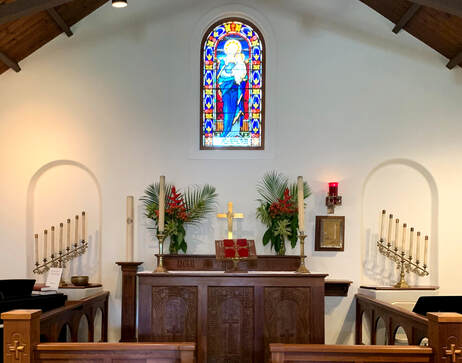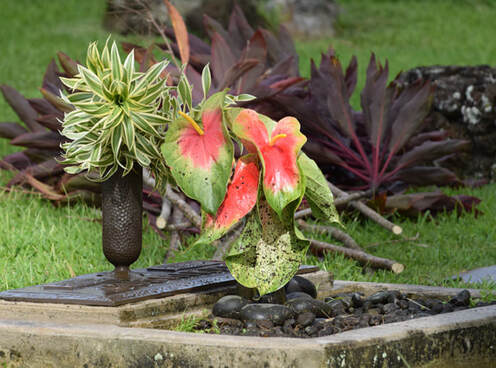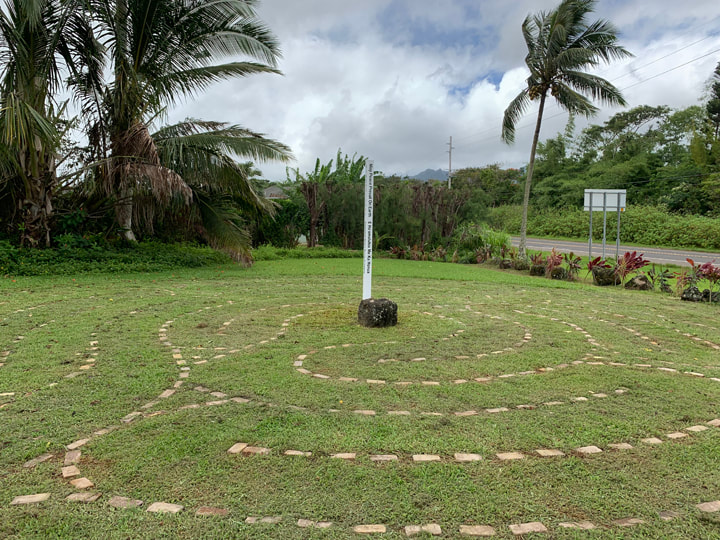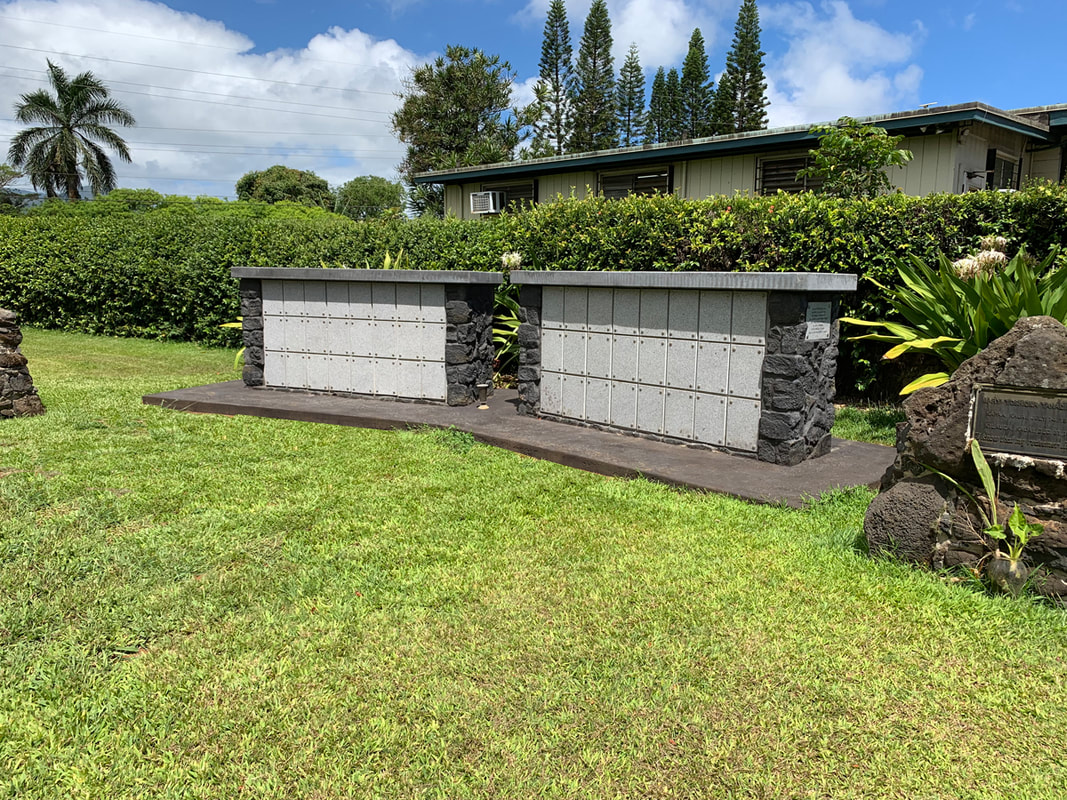OUR HISTORY & GROUNDS
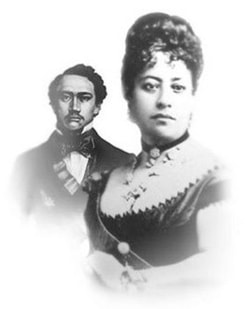
The Episcopal Church in Hawai'i began in 1862 when King Kamehameha IV and Queen Emma invited the Church of England to Hawai‘i. The King and Queen supported the Church's establishment throughout the islands with gifts of land, and by founding the Cathedral of St. Andrew in Honolulu. Queen Emma also founded Queen's Hospital (now Queen's Medical Center) and St. Andrew's Priory School for Girls in Honolulu.
As early as 1888 worship services were held in Kilauea under the direction of lay leadership and Bishop Willis. Bishop Willis had been sent to Hawai`i by the Church of England and on occasion, confirmed people in Kilauea. By 1924 the time had come for a permanent church in Kilauea, and under the leadership of Bishop LaMothe and the Rev. Henry Willey, Episcopalians in the area started worshipping in a frame building owned by the Hawaiian Congregational Church.
In 1939 the Kilauea Sugar Company deeded the churchyard to the Episcopal Diocese of Hawaii and gave the native stone used in the erection of our present building. The chief benefactor, however, was Mrs. Robert Shapard, of Griffin, Georgia, in memory of her husband, and on the Second Sunday after Epiphany on January 19, 1941, the Right Rev. Harrington Littell consecrated the church.
As early as 1888 worship services were held in Kilauea under the direction of lay leadership and Bishop Willis. Bishop Willis had been sent to Hawai`i by the Church of England and on occasion, confirmed people in Kilauea. By 1924 the time had come for a permanent church in Kilauea, and under the leadership of Bishop LaMothe and the Rev. Henry Willey, Episcopalians in the area started worshipping in a frame building owned by the Hawaiian Congregational Church.
In 1939 the Kilauea Sugar Company deeded the churchyard to the Episcopal Diocese of Hawaii and gave the native stone used in the erection of our present building. The chief benefactor, however, was Mrs. Robert Shapard, of Griffin, Georgia, in memory of her husband, and on the Second Sunday after Epiphany on January 19, 1941, the Right Rev. Harrington Littell consecrated the church.
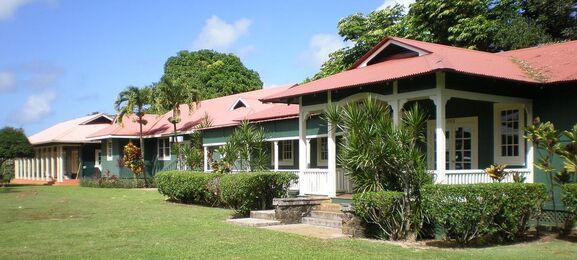
Parish Hall
The structure that is now the Christ Memorial Episcopal Church Parish Hall was built in 1925. The building material, at a cost of $5,600 was donated by the Kilauea Japanese Association. The Sugar Plantation donated the labor for its construction. It was used as a place of worship for the Buddhist people (the father of our own Auntie Helen Mitsui, Thrift Shop Manager, served as a Buddhist priest.) A Japanese Language School was established as well. The property was leased from the Sugar Plantation to the Japanese Association for $1.00 a year.
As World War II began, the Christ Memorial Episcopal Church Parish Hall was given to the Kilauea Sugar company. The Buddhist worship was discontinued, and the Japanese Language School terminated. The building, as many others on Kauai, was used as billeting for Army officers. After the war, Kilauea Japanese Association was reactivated.
The building was then leased to Christ Memorial Church. But the thriving Sugar community of Kilauea was in for a shock. In 1970 it was announced that the sugar company would close. This little Parish House was witness to huge changes. It was expected that, as the company sold off their land, that the tiny village community would vanish.
But many of the multinational “melting pot” community members did not want to leave Kilauea. C. Brewer company (the Sugar company,) the ILWU, county, state and federal officials all worked together to make a subdivision possible. Christ Memorial led the Kilauea Community Outreach Program, funded by the Episcopal Church, and St. Sylvesterʻs Catholic Church joined to help. The group carried on events and planning, much like the Plantation once did. Later the Kilauea Neighborhood Association, of which we are still a sponsor, became a model of working together to address opportunities and threats to the town.
In 1976 the Episcopal Diocese of Hawaii purchased the property for use by Christ Memorial. By the year 1979 the building was in poor condition – the roof leaked, the paint, inside and out, was peeling, and the old foundation was deteriorating. The Bishopʻs Committee decided to act to renovate the Parish Hall. The renovation was completed in 1981, and Bishop Edmund Browning blessed the building at the annual meeting of the church.
But another historic event destroyed the building in 1992 – Hurricane Iniki. The Parish Hall had to be rebuilt. The Rev. Shinkai Murakami, a Buddhist priest from the Kapaa Hongwanji mission, came to deconsecrate the Buddhist altar portion of the building. The reconstruction of the Parish Hall was completed on January of 1995, at a cost of over $91,000, and blessed by Father Donor MacNeice.
We honor today the generations of those who worshipped at the Parish Hall, along with the melting pot of Sugar workers, those who rebuilt and maintain this great place. We are thankful today as well for the service provided to this community by our Parish Hall today. We are happy to have the myriad groups who, in our Parish Hall, provide music, martial arts, yoga, AA meetings, and so much more, to the community.
The structure that is now the Christ Memorial Episcopal Church Parish Hall was built in 1925. The building material, at a cost of $5,600 was donated by the Kilauea Japanese Association. The Sugar Plantation donated the labor for its construction. It was used as a place of worship for the Buddhist people (the father of our own Auntie Helen Mitsui, Thrift Shop Manager, served as a Buddhist priest.) A Japanese Language School was established as well. The property was leased from the Sugar Plantation to the Japanese Association for $1.00 a year.
As World War II began, the Christ Memorial Episcopal Church Parish Hall was given to the Kilauea Sugar company. The Buddhist worship was discontinued, and the Japanese Language School terminated. The building, as many others on Kauai, was used as billeting for Army officers. After the war, Kilauea Japanese Association was reactivated.
The building was then leased to Christ Memorial Church. But the thriving Sugar community of Kilauea was in for a shock. In 1970 it was announced that the sugar company would close. This little Parish House was witness to huge changes. It was expected that, as the company sold off their land, that the tiny village community would vanish.
But many of the multinational “melting pot” community members did not want to leave Kilauea. C. Brewer company (the Sugar company,) the ILWU, county, state and federal officials all worked together to make a subdivision possible. Christ Memorial led the Kilauea Community Outreach Program, funded by the Episcopal Church, and St. Sylvesterʻs Catholic Church joined to help. The group carried on events and planning, much like the Plantation once did. Later the Kilauea Neighborhood Association, of which we are still a sponsor, became a model of working together to address opportunities and threats to the town.
In 1976 the Episcopal Diocese of Hawaii purchased the property for use by Christ Memorial. By the year 1979 the building was in poor condition – the roof leaked, the paint, inside and out, was peeling, and the old foundation was deteriorating. The Bishopʻs Committee decided to act to renovate the Parish Hall. The renovation was completed in 1981, and Bishop Edmund Browning blessed the building at the annual meeting of the church.
But another historic event destroyed the building in 1992 – Hurricane Iniki. The Parish Hall had to be rebuilt. The Rev. Shinkai Murakami, a Buddhist priest from the Kapaa Hongwanji mission, came to deconsecrate the Buddhist altar portion of the building. The reconstruction of the Parish Hall was completed on January of 1995, at a cost of over $91,000, and blessed by Father Donor MacNeice.
We honor today the generations of those who worshipped at the Parish Hall, along with the melting pot of Sugar workers, those who rebuilt and maintain this great place. We are thankful today as well for the service provided to this community by our Parish Hall today. We are happy to have the myriad groups who, in our Parish Hall, provide music, martial arts, yoga, AA meetings, and so much more, to the community.
|
The Stained Glass Windows
Christ Memorial Episcopal Church is one of the most picturesque Episcopal churches in the Hawaiian Islands. It is noted for its' magnificent stained glass windows that many people come to photograph. The windows were executed in England and are of the very best design and workmanship. They were reworked in 1968 to insure their long life. The rose window over the front door is of a traditional design and is basic to traditional Anglican Church architecture. The side and front windows portray the life of Jesus Christ, beginning with the window over the Altar and continuing in a counter-clockwise direction: The Infant Jesus and His Mother; Christ in the Temple; The Baptism of Jesus; The Sower; The Good Shepherd; Christ as Priest; Christ in Gethsemane; The Crucifixion; The Resurrection; The Ascension of Christ. |
|
|
The Altar
Of the many memorial gifts given to the church, four are especially worth noticing. One is the Altar, its panels hand-carved by Mrs. Harrison Rice. It shows four basic symbols of Christianity: the cross, grapes, wheat and the passion flower. The others are the magnificent stained glass windows, all executed in England and re-worked in 1968. A beautiful locally hand-carved Honduran Mahogany Altar Rail was given to the church by Mrs. Dorothy Bridges in memory of her husband Lloyd Bridges. The rail was dedicated in the presence of Mrs. Bridges and her family on Easter Sunday 2000. |
Graveyard
The graveyard surrounding the church dates back to the earliest days of the original Hawaiian Congregational Church, with many graves dating back over 100 years. Unfortunately, many graves are unmarked and the number of people buried here will probably remain a secret known only to God. Visit our Historic Preservation page to read more about our graveyard ministry. |

